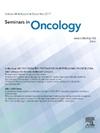外泌体环状rna作为胶质母细胞瘤替莫唑胺耐药的驱动因素:机制和意义
IF 2.5
3区 医学
Q2 ONCOLOGY
引用次数: 0
摘要
胶质母细胞瘤(GBM)仍然是最恶性的肿瘤之一,治疗成功有限,主要是由于对替莫唑胺TMZ的耐药性的出现。在GBM中,对TMZ的抗性是一个多因素现象,取决于遗传、表观遗传和微环境因素之间的相互作用。非编码rna,尤其是环状rna,最近被强调在GBM的发病机制和对TMZ的耐药性中发挥重要作用。这些稳定的环状RNA分子可以作为microRNA海绵或编码功能性肽;因此,它们调节与肿瘤发展的不同方面有关的功能。此外,circRNAs可以在外泌体中携带,促进细胞间通讯和耐药性的传播。外泌体作为复杂的递送载体,包含各种生物活性分子,如蛋白质、脂质、mrna、mirna、lncrna和许多其他分子,包括环状rna。这篇综述阐明了外泌体环状rna(如circASAP1和circ-HIPK3)通过不同的分子途径在TMZ耐药调节中所具有的特定功能。它还反映了外泌体环状rna作为诊断和预后的生物标志物潜力,允许它们在液体活检中动态应用,以监测GBM的进展。这篇综述试图发展对TMZ耐药机制的复杂性的理解,特别关注外泌体环状rna的潜在作用的新见解。本文章由计算机程序翻译,如有差异,请以英文原文为准。
Exosomal circular RNAs as drivers of temozolomide resistance in glioblastoma: Mechanisms and implications
Glioblastoma (GBM) continues to be 1 of the most malignant tumors with limited success in therapy, primarily owing to the emergence of resistance towards temozolomide TMZ. Resistance to TMZ is a multifactorial phenomenon in GBM, depending on the interactions between genetic, epigenetic, and microenvironmental factors. Noncoding RNAs, most significantly circRNAs, have recently been highlighted as playing important roles in the pathogenesis of GBM and drug resistance against TMZ. These stable, circular RNA molecules can act as microRNA sponges or encode functional peptides; hence, they modulate functions relating to different aspects of tumor development. Furthermore, circRNAs can be carried within exosomes, promoting intercellular communication and propagation of drug resistance. Exosomes serve as sophisticated delivery vehicles that harbor varying bioactive molecules like proteins, lipids, mRNAs, miRNAs, lncRNAs, and many others, including circular RNAs. This review elucidates the specific functions held by exosomal circRNAs, such as circASAP1 and circ-HIPK3, in the modulation of TMZ resistance through different molecular pathways. It also reflects the biomarker potential of exosomal circRNAs as diagnostics and prognostics, allowing their dynamic application in liquid biopsies to monitor the progression of GBM over time. This review tries to develop an understanding of the complex nature of mechanisms conferring resistance to TMZ, with a particular focus on new insights regarding the potential roles of exosomal circular RNAs.
求助全文
通过发布文献求助,成功后即可免费获取论文全文。
去求助
来源期刊

Seminars in oncology
医学-肿瘤学
CiteScore
6.60
自引率
0.00%
发文量
58
审稿时长
104 days
期刊介绍:
Seminars in Oncology brings you current, authoritative, and practical reviews of developments in the etiology, diagnosis and management of cancer. Each issue examines topics of clinical importance, with an emphasis on providing both the basic knowledge needed to better understand a topic as well as evidence-based opinions from leaders in the field. Seminars in Oncology also seeks to be a venue for sharing a diversity of opinions including those that might be considered "outside the box". We welcome a healthy and respectful exchange of opinions and urge you to approach us with your insights as well as suggestions of topics that you deem worthy of coverage. By helping the reader understand the basic biology and the therapy of cancer as they learn the nuances from experts, all in a journal that encourages the exchange of ideas we aim to help move the treatment of cancer forward.
 求助内容:
求助内容: 应助结果提醒方式:
应助结果提醒方式:


